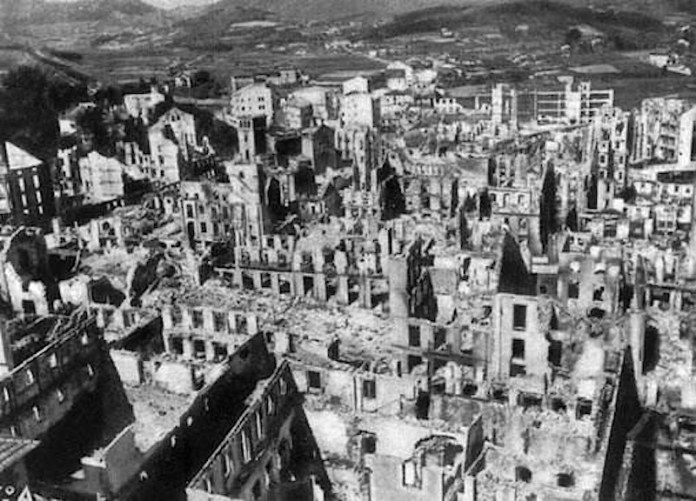One of the most infamous episodes in the Spanish Civil War is the bombing of Gernika, in which the German Luftwaffe’s Condor Legion attacked the Basque town on Monday, April 26, 1937, starting around 4:30pm in the afternoon. Monday was a market day, normally bringing thousands of people to the small town in the heart of Bizkaia. From the German point of view, this attack was a test of so-called terror bombing, in which civilians are attacked to break the will of the enemy.

- The town of Durango lies some 28 kilometers from Gernika. It was bombed on March 31, 1937. Durango was viewed as an important transportation junction between the front and Bilbao. German and Italian planes, modified to drop bombs, attacked the town, which had no air defenses. About 250 people died that day. Two churches were bombed during mass, and in one 14 nuns and the officiating priest were killed.
- Earlier on the same day that Gernika was bombed, the small towns of Gerrikaitz and Arbatzegi (collectively known as Munitibar) were also bombed and machine-gunned. About 11 people were killed during those attacks. Other towns surrounding the mountain Oiz were also attacked, including Markina, Ziortza-Bolibar, Arratzu, Muxika and Errigoiti.
- The raid on Gernika was originally reported by South African journalist George Steer, who sent a telegram to London describing the bombing and the German markings on the casings. At one point, Steer hid in a bomb crater in Gerrikaitz to escape machine gun fire from German planes.
- The raid on Gernika was led by Wolfram Freiherr von Richthofen, who was the fourth cousin of Manfred von Richthofen, the infamous Red Baron. Much of what we know about the German planning of the attack comes from his diaries.
- Of course, the bombing of Gernika is the source of inspiration for Pablo Picasso’s painting Guernica.
- Though the numbers are uncertain and in some dispute, between 150 and 1500 people died that day. While many modern historians place the death toll to something less of 300 people, Xabier Irujo argues convincingly in Gernika, 1937: The Market Day Massacre that a figure of 1500 is more likely.
- One of the last survivors of the bombing of Gernika, Luis Ortiz Alfau, died on March 8, 2019.
Discover more from Buber's Basque Page
Subscribe to get the latest posts sent to your email.


My 87 year old mother is a Gernika bombing survivor. She was 5 years old that day.
Interesting link to the death notice of Luis Ortiz Alfau(the 102 year old bombing survivor).
My family was in Arbatzegi when the hamlet was bombed by the German planes and the roads machine gunned. Eulalia Lizundia, a sister of my atite Fernando was seriously wounded by shrapnel to the head and the family house partially demolished by a direct hit.
But the worst, as you say in your article, had taken place a few days earlier in Durango. The town was bombed in the morning by the Italian Regia Aeronautica, while villagers were attending mass. Most of the fatalities occurred in the churches.
But still worse, to add insult to injury, Italian fighters came flying low, to avoid detection, late in the afternoon and straffed the funeral processions heading for the cemetery.
Much has been said and written about the dreadful acts of the nazi Condor Legion, but very little about the atrocities committed by the Regia Aeronautica and the Italian army.
The most horrible crime of the Spanish Civil war happened on the coastal road from Malaga to Almeria on february 8, 1937, and the Italians were also involved in it.
Francoist ans Italian battleships and planes gunned for hours the tens of thousands of defenceless civilians fleeing the war on the narrow road (today known as N-340), with nowhere to hide or take cover. Between 3.000 and 8.000 people, mostly women and children were killed in cold blood. This war crime is known as The Big Stampede or La Desbandá.
May them rest in peace. Goian bego.
Thanks for all of this info. I will have to look into this more. No one I’ve talked to in Arbatzegi ever brought this up so it isn’t clear to me if people still remember much. Is there still physical evidence of the bombing, or has it all faded away by now?
There are no traces left in Arbatzegi, as far as I know. Neither in Gernika. People needed to resume normalcy as soon as possible. https://goo.gl/maps/QhQW3vK74sP377jQ7 The white house to the left, ssen on this capture of Google maps, was built some time ago in the same place where stood the baserri hit by the bomb.
My Grandmother ran for the hills with her family she was a very small child .